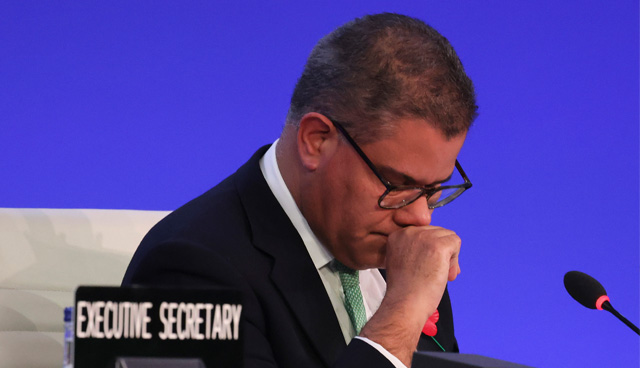COP26: The Glasgow Climate Pact

While many will celebrate the inclusion of tackling coal and fossil fuels for the first time in a COP final decision, others have pointed to the stark reality that COP26 did little to change the trajectory of expected global warming of 2.4ºC by 2030.
Current national plans to cut emissions, if implemented, fall short of ambitions to ‘limit global warming to “well below 2ºC, ideally 1.5ºC, since pre-industrial times”. Despite a heightened awareness of the need to address climate change globally, only one of the world’s major emitters, India, produced new Nationally Determined Contributions (NDC) at the conference, with the emphasis for enhanced national ambitions seemingly pushed for following years.
Under the guidelines of the Paris Agreement, nations are only required to set new NDCs every five years. An original roadmap set out a vision that this would occur in 2025, with the focus at that time being on actions beyond 2030. However, estimations are that current NDCs will be inadequate to limit global warming to the required level, with a 2.4ºC rise predicted by 2030 on the current trajectory. While calls for fresh NDCs to be produced in Glasgow were largely ignored, some progress was achieved in ensuring that NDCs have been put on the agenda for COP27 in Egypt and COP28 in 2023.
“While not as ambitious as most would have hoped, the inclusion of a phase down commitment still represents significant progress.”
Importantly, there now appears to be a greater unison between leading nations on what the global temperature rise limiting target should be. Some nations had argued that an aim of 1.5ºC would be a rewrite of the Paris Agreement’s actual commitment. At COP26, however, nations such as the US and the UK emphasised that the “well below 2ºC” target must be sought, an ambition largely agreed by participating nations.
Coal
Coal took centre stage as both the biggest achievement and potentially biggest disappointment of COP26. The Glasgow Climate Pact looked set to include a historic pledge by all nations to phase out coal-fired generation but opposition from some of the world’s largest users forced a retreat in ambition, with the final text including a pledge to ‘phase down’ use. The International Energy Agency estimates that some 40 per cent of the world’s existing coal-fired power plants will need to be closed by 2030 if global warming is to be limited to 1.5ºC but to date, fossil fuel-producing companies and heavy consumers of oil and coal have been successful in keeping the phasing out of fossil fuels off the COP agenda. While not as ambitious as most would have hoped, the inclusion of a phase down commitment still represents significant progress.
Climate reparation
Much like the issue of revised national targets, also pushed on to COP27 was a mechanism to help fund nations to deal with loss or damage associated with climate change. It has long been argued that unpreventable or unmanageable climate events, such as hurricanes and flooding have a direct effect on the resources of developing countries, forcing them to spend budgets on repairing damage rather than proactively mitigating climate change. Richer nations have, for a long time, sought to oppose a financing mechanism which could be viewed as a compensation or reparation scheme, recognising the potential costs associated with legal liability for climate damage.
Key pledges
Coal and fossil fuel: To “accelerate efforts towards” phasing down “unabated coal power” and to bring about an end to “inefficient” fossil fuel subsidies.
Loss and damage: Beginning of a “dialogue” on funding a new organisation to support countries affected by climate change.
Climate finance: Increase in climate finance for poorer nations to at least meet the previously set out $100 billion target per year, through to 2025. Rich nations will double their support for adaptation measures to help developing countries.
Carbon markets: The rules will create a market for units representing emissions reductions that countries can trade, under so-called Article 6.
Trees: Over 100 nations pledged to end deforestation by 2030.
Methane: Large methane emitters including Russia, China and India did not join in pledging to a scheme to cut 30 per cent of methane emissions by 2030.
COP25 produced some progress on the issue, including the establishment the Santiago Network, a reporting and database system, however no funding mechanism was discussed at COP26.
Climate finance
Pre-COP26, a lot had been made of a failure by richer countries to honour a pledge to aid poorer countries to cut emissions through public and private financing. In 2009, it was agreed that $100 billion would be raised annually, however in 2019, the most recent data available, only $80 billion had been allocated. Richer countries reacted to anger from developing countries at COP26 by pledging to increase finance to ensure $500 billion will be available for the next five years.
Crucially, the Glasgow Climate Pact has introduced a shift to where that finance will be directed. The text agreed to double the proportion of climate finance going to adaption. The agreement falls short of the UN recommendation for an even split, recognising current top-heavy investment in emissions-cutting projects because of their viability to return a profit. However, the move is seen as progress for those poorer countries who face extreme weather and struggle to obtain investment.
The success of the Glasgow Climate Pact will rest on whether nations are prepared to transmit their pledges at COP26 into legally binding ambitions nationally. The Glasgow Pact is not legally binding, meaning that domestic responsibility will play a huge role in limiting global warming to acceptable levels. Outside of the inclusion of fossil-fuels as an issue which needs addressed at COP26, it appears that next year’s pledges expected by nations, could be a defining moment in the climate crises.





